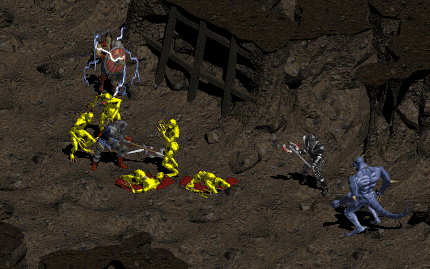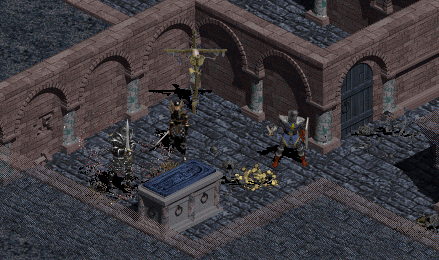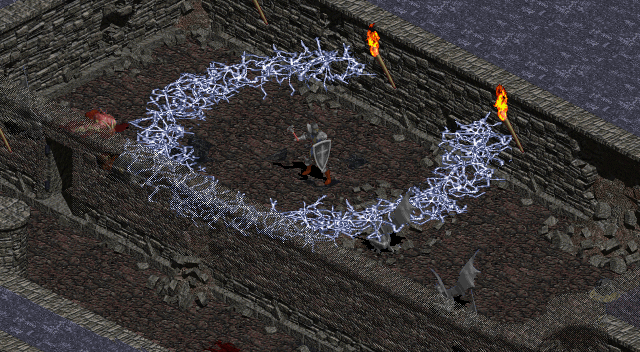 |
Diablo - Retroview |
 |
A Good Blizzard Evidently Has A Better Chance In Hell Than A Snowball
By: Andrew Long
| Review Breakdown |
| Battle System |
6 |
| Interface |
6 |
| Music/Sound |
8 |
| Originality |
9 |
| Plot |
3 |
| Localization |
n/a |
| Replay Value |
8 |
| Visuals |
8 |
| Difficulty |
Variable |
| Time to Complete |
10-25 hours
|
|
| Overall |
 |
| Criteria
|

|
| |
There's something to be said for a videogame developer that consistently turns out successful titles with nary a disaster in between. With a PC track record rivalled by few others in the business, Blizzard Entertainment enjoys that distinction, and one of its earlier titles bears all the hallmarks that make its games successful. Addictive gameplay, careful attention to detail, and just enough variety to make things worth doing over and over again are just a few of the elements that tend to set the company's games apart. Add to that excellent graphics for its time and hauntingly good music, with delicious sound effects thrown in for good measure, and it's not hard to see why Diablo has endured the test of time to remain an upstanding example of Blizzard's prowess. While marred by a cheat-ridden multiplayer mode and surpassed in almost every respect by its sequel, Diablo is one of those games that keep players coming back for just one more game in spite of its age.
An atmospheric game from the very start, Diablo drops the player unceremoniously at the outskirts of Tristram, a quaint little village in the middle of nowhere. It's evening, and there have been some spooky goings-on at the local church. As an intrepid wanderer, it only makes sense to venture into the church's dank basement to see what's behind the town's problems. That's about all Diablo offers in terms of plot, but really, that's all it needs. A classic action-based RPG, the objective in Diablo is to hack, slash, and brain one's way through sixteen levels of demons, skeletons, imps, giant snakes, and all other manner of unpleasant creatures.
Diablo is the original cool when it comes to carpal-tunnel syndrome-inducing clickfests, and none of the three character classes is exempted from this particular feature. Sorcerers cast spells repeatedly, rangers fire off bushels of arrows in all directions, and fighters hack and slash their way to glory. There is some overlap between the skills for the three classes, but in general, this is restricted by the distribution of skill points. At the beginning of the game, these figures are set according to class, and it is thereafter advisable to distribute them in such a way as to keep the character's class attributes the highest. This isn't to say that it's not possible to make a sorceror who just happens to wield a giant broadsword- heck, Gandalf knew how to bust stuff up when the going got tough; it's just easier to stick to the pre-ordained route suggested by the initial distribution.

|
| Blue demon watches pensively as yellow demons get ground into dogmeat
|
|
This is because these stats govern which items can be used, and how. Items are the addictive element in Diablo, and the incentive for mindlessly felling skeleton after skeleton after skeleton and risking death in the face of irritatingly explosive barrels. Weapons, armour, and spellbooks are all acquired by killing monsters, and it doesn't stop there. There are also magical and unique items. Magical items are created based upon the random assignment of bonuses that range from Pretty Good to Really Good, while Uniques tend to be somewhat better, although not universally so. Spellbooks work cumulatively; each spellbook of a specific spell increases its level (and effectiveness) and can only be read if a player's magic statistic has reached a certain level, much in the same way weapons and armour are governed by strength and agility attributes.
It's also possible to find potions in the sea of wreckage left behind after a killing spree, and these are critical to keeping health levels up. On the downside, only a limited amount of storage space is available, and this is where the interface comes into play. Easily accesible through the use of hotkeys, it is nonetheless somewhat irksome that items cannot be rotated to allow for more space, since backpack space is quite limited. Gold also takes up precious inventory space, so it's usually advisable to travel light.
Travel light or travel heavy, at least there's good music along the way. Diablo's composer has fitted together quite a decent soundtrack which, though limited in scope, features some very nice music that perfectly fits (and helps create) the game's atmosphere. In particular, the theme for the town of Tristram is very memorable, and features some amazingly clear instrumentation sampling for its time. Other tunes are also well-crafted, and the game's sound effects convey suitable squelching, thwacking, and bashing to make the carnage that much more addictive. About the only complaint to be made about the aural side of the game is the lack of variety, and that is not terribly problematic.
Diablo is a game that helped to shape its genre, and it is not uncommon to hear games referred to as "Diablo clones". This lends weight to the assertion that the game is an original creation, which is not too hard to make in light of the game's fundamentally successful elements. Certainly, hack-and-slash or shooter-type games existed before Diablo, but it brought an acquisitive side to things that other games of its time lacked. It also took the genre online with the inauguration of the battle.net service, and while this version of the game was horribly marred by cheating, it helped pave the way for many of the MMORPGs of today, as well as non-massively multiplayer titles that are nonetheless online.

|
| The nervous sport of tomb-robbing |
|
Regrettably, it didn't do too much in the way of revolutionizing storytelling. While the game offered a number of sidequests and a decent-sized cast of characters, their role in the game was decidedly secondary to the gameplay. Certainly, buying stuff off local urchin Wirt or beating up on the Butcher are entertaining sidelines, but they hardly qualify as compelling storytelling. The only saving grace is the extensive backstory, and this is largely included in the manual rather than the game itself. Still, as the plot is relatively unimportant to the game, this is hardly too critical a failing.

|
| Because emitting chain lightning is just cool |
|
Diablo's online play, randomly generated dungeons, and acquisitive goodness all help to augment its replay value. While the levels are, at a basic level, the same thing every time, there's just something compelling about trying to find a ring with just the right ultimate attribute improvements, or going through hell with a group of people online one more time just for the hell of it. There are also variable difficulty levels, meaning that no two playthroughs are exactly alike (online, these difficulty levels act as a filter for who can play what levels). This openendedness gave Diablo a level of replayability unseen in most games of its day, and help ensure that it remains enticing to pick it up and play it every so often to this day. There is also an expansion pack put out by Sierra that adds a fourth character class, giving players further incentive to go through just once more.
Another helpful element in this respect is the fact that the graphics have not aged too terribly. Incredible attention to detail has been paid, and it shows. The environments are all beautifully conceived, while the dungeon stages are all suitably dark and spooky. Some of the character sprites are a little ugly around the edges, but a testament to the overall quality of the images is the fact that at least one of the character models was recycled in Diablo II. About the only problem the game suffers from is being slightly too dark at times. Additionally, the mini-map overlay can be a trifle distracting at times, but this is more an interface issue than a visual one.
In the end, Diablo will go down in PC history as a groundbreaking title. Not only did it set in place a number of elements that many later games would incorporate, it opened the doors to online play, and while this experience was often marred by cheating, it offered a glimpse of things to come. In most respects, Diablo II outstripped its predecessor, but at the same time, Diablo provided an eminently strong foundation upon which to build a sequel. That fact, combined with a healthy dose of nostalgia, makes Diablo one of the most enjoyable PC games of yesteryear, and perhaps, of all time.
|










